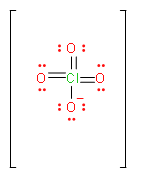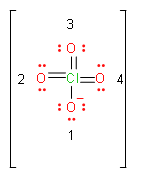
The bond order of \[Cl-O\] bond in \[ClO_{4}^{-}\] ion and the effective charge on each oxygen atom respectively are:
A. 1.75,-1
B. 1.75, -0.25
C. 1.5, -0.5
D. 2.0, -0.5
Answer
428.7k+ views
Hint: To solve these types of questions we should first draw the Lewis structure. And then after it, we then count the number of total bonds and then divide it by the number of elements in which these bonds are made with the central atom.
Step by step answer:
We can solve this question, by first drawing the Lewis dot structure of \[ClO_{4}^{-}\] ion.

In the above figure, the total number of bonds is 7. And if we try to draw different structures, these bonds will rearrange themselves between four elements. Or we can calculate it by counting the number of resonance structures this molecule can make.
$Bond\,order=\dfrac{total\,number\,of\,bonds}{total\,number\,of\,resonance\,structures}$\[\begin{align}
& Formal\text{ }charge\,of\,first\,oxygen=6-6-\dfrac{2}{2}=-1 \\
& Formal\text{ }charge\,of\,\sec ond,\,third\,and\,fourth\,oxygen=6-4-\dfrac{4}{2}=0 \\
\end{align}\]
\[Bond\,order=\dfrac{7}{4}=1.75\]
So, from the above calculation we found that the bond order of perchlorate ion is 1.75.
Now, we will calculate formal charge on each oxygen atom. First we assign numbers to oxygen atoms.

\[Formal\text{ }charge=\text{ }valence\text{ }electrons-unbonded\,electrons-\dfrac{1}{2}bonded\,electrons\]
\[\begin{align}
& Formal\text{ }charge\,of\,first\,oxygen=6-6-\dfrac{2}{2}=-1 \\
& Formal\text{ }charge\,of\,\sec ond,\,third\,and\,fourth\,oxygen=6-4-\dfrac{4}{2}=0 \\
\end{align}\]
So, effective charge on oxygen will become -0.25.
From the above discussion and calculation, we can now say that the answer of this question is option B.
Additional information:
We should know that perchlorate is a chemical compound containing the perchlorate ion \[ClO_{4}^{-}\]. The majority of perchlorates are commercially produced salts. They are mainly used for propellants, exploiting properties as powerful oxidizing agents and to control static electricity in food packaging. Most perchlorates are colourless solids that are soluble in water.
Note: We should also know about bond length. It is defined as the distance between the centres of two covalently bonded atoms. The length of the bond is determined by the number of bonded electrons (the bond order). If bond order is high, there will be stronger pull between two atoms and there will be shorter bond length. Therefore, bond length increases in the following order: triple bond < double bond < single bond.
Step by step answer:
We can solve this question, by first drawing the Lewis dot structure of \[ClO_{4}^{-}\] ion.

In the above figure, the total number of bonds is 7. And if we try to draw different structures, these bonds will rearrange themselves between four elements. Or we can calculate it by counting the number of resonance structures this molecule can make.
$Bond\,order=\dfrac{total\,number\,of\,bonds}{total\,number\,of\,resonance\,structures}$\[\begin{align}
& Formal\text{ }charge\,of\,first\,oxygen=6-6-\dfrac{2}{2}=-1 \\
& Formal\text{ }charge\,of\,\sec ond,\,third\,and\,fourth\,oxygen=6-4-\dfrac{4}{2}=0 \\
\end{align}\]
\[Bond\,order=\dfrac{7}{4}=1.75\]
So, from the above calculation we found that the bond order of perchlorate ion is 1.75.
Now, we will calculate formal charge on each oxygen atom. First we assign numbers to oxygen atoms.

\[Formal\text{ }charge=\text{ }valence\text{ }electrons-unbonded\,electrons-\dfrac{1}{2}bonded\,electrons\]
\[\begin{align}
& Formal\text{ }charge\,of\,first\,oxygen=6-6-\dfrac{2}{2}=-1 \\
& Formal\text{ }charge\,of\,\sec ond,\,third\,and\,fourth\,oxygen=6-4-\dfrac{4}{2}=0 \\
\end{align}\]
So, effective charge on oxygen will become -0.25.
From the above discussion and calculation, we can now say that the answer of this question is option B.
Additional information:
We should know that perchlorate is a chemical compound containing the perchlorate ion \[ClO_{4}^{-}\]. The majority of perchlorates are commercially produced salts. They are mainly used for propellants, exploiting properties as powerful oxidizing agents and to control static electricity in food packaging. Most perchlorates are colourless solids that are soluble in water.
Note: We should also know about bond length. It is defined as the distance between the centres of two covalently bonded atoms. The length of the bond is determined by the number of bonded electrons (the bond order). If bond order is high, there will be stronger pull between two atoms and there will be shorter bond length. Therefore, bond length increases in the following order: triple bond < double bond < single bond.
Recently Updated Pages
Average fee range for JEE coaching in India- Complete Details

Difference Between Rows and Columns: JEE Main 2024

Difference Between Length and Height: JEE Main 2024

Difference Between Natural and Whole Numbers: JEE Main 2024

Algebraic Formula

Difference Between Constants and Variables: JEE Main 2024

Trending doubts
Learn About Angle Of Deviation In Prism: JEE Main Physics 2025

Physics Average Value and RMS Value JEE Main 2025

Electromagnetic Waves Chapter - Physics JEE Main

Collision - Important Concepts and Tips for JEE

Which of the following is steam volatile A oNitrophenol class 11 chemistry JEE_Main

aHgS + bHCl + cHNO3 to dH2 + HgCl4 + eNO + f S + gH2O class 11 chemistry JEE_Main

Other Pages
NCERT Solutions for Class 11 Chemistry Chapter 9 Hydrocarbons

NCERT Solutions for Class 11 Chemistry Chapter 7 Redox Reaction

Physical Chemistry

NCERT Solutions for Class 11 Chemistry Chapter 8 Organic Chemistry

NCERT Solutions for Class 11 Chemistry Chapter 6 Equilibrium

Equilibrium Class 11 Notes: CBSE Chemistry Chapter 6




